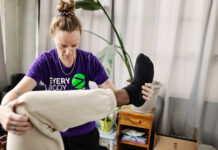Stepping out into frigid temperatures with cold, tight muscles never feels good and could be putting you at risk. Whether you are a weekend runner or a Winter Olympian, a proper warm-up is critical for optimal performance and injury prevention.
Here’s what you need to know:
- An aerobic warm-up gets oxygen-rich blood flowing to the muscles. Raising the heart rate warms the core and peripheral body temperature to make soft tissues more resilient and pliable.
- Lubrication of the joint surfaces through dynamic range of motion exercises decreases resistance and improves mobility.
- Practicing muscle recruitment patterns will prime the nervous system to help co-ordination of complex, powerful or quick movements.
- Progressive loading of tissues by gradually adding speed or resistance prepares them to handle forces safely.
- A well-executed warm-up can help prepare you mentally by clearing your head of distractions allowing you to focus on your sport.
Professional athletes take their warm-ups seriously. Before a bobsled race, athletes spend 30-45 minutes warming up to prepare to push a 465 pound sled for five seconds over 50 metres, before jumping into the sled.
Recreational athletes commonly warm up on the go with lighter exercise building into more strenuous activity. It takes most athletes between 10-20 minutes of movement to heat up and be ready for higher-level performance. Even if you are pressed for time, taking 5 minutes for sport specific exercises on top of an aerobic warm up will have a positive impact on your workout. The goal is not to be fatigued, but ready to go.
The Routine
Here are five movements that will help prepare the body and activate key muscles for your winter activities. Do the exercises in a nonstop sequence to maintain your core temperature and prepare your body and muscles for activity. Exercises can be done inside or outside.
1. Aerobic Warm Up
Jog or skip for 5-10 minutes to increase the heart rate and raise core body temperature.
2. Squats
Loop a mini-band above your knees and do 5-10 bodyweight squats. The band will drive your knees inward, activating your hip abductors as you push the band outwards. To increase the difficulty and challenge your balance, squat on one leg. Start slowly and gradually increase the speed of the squat.
Sit back as you squat to activate your posterior chain of muscle including the gluteals and hamstrings.

Photo: Dave Holland
3. Three-Way Hip Activation
With a mini-band around your ankles, stretch the band apart in three different directions:
- Turn your hip inward and stretch band to the front at a 45 degree angle.
- Turn your hip outward and pull back at a 45 degrees angle.
- Extend your hip straight back, ensuring you do not over-arch your lower back.
Hold each position for 5 seconds and do 5-10 repetitions, enough times to notice the muscles around your hip working, but not so much that you feel fatigue. Keep your pelvis square and level. Keep your knee extended on the leg that you are pulling with to ensure optimal contraction of your hip muscles.

Photo: Dave Holland
4. Bird Dog
In a hands and knees position, engage your core, extend the opposite arm and leg and hold the position for 5 seconds. To increase the difficulty, try using a Theraband or sport cord. Do 10-15 repetitions each side.

Photo: Dave Holland
5. Hip Swings
Hip Adduction/Abduction and Hip Flexion/Extension. Support yourself against a wall, bench or post; swing your legs side-to-side and forward and back. Swing 10-20 times in each direction for each side.

Photo: Dave Holland
















